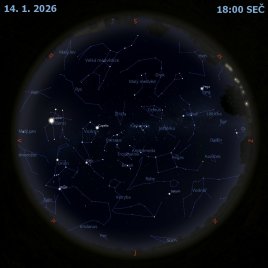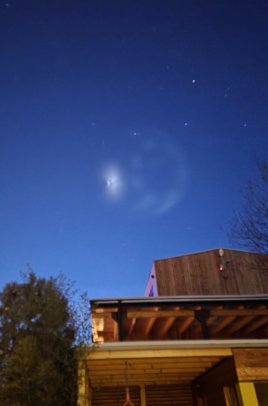Odraz slunečního světla na mořích Titanu

Uznání: NASA, JPL-Caltech, U. Arizona, U. Idaho
Proč by se měl povrch Titanu rozsvítit jasným zábleskem? Protože se v kapalných mořích třpytí slunce. Saturnův měsíc Titan má četná hladká jezera metanu, která při správném úhlu odrážejí sluneční světlo jako zrcadla. Na snímku ve falešných barvách z kosmické sondy Cassini, která v letech 2004 až 2017 snímkovala Saturn, je zobrazen mraky zatažený Titan v roce 2014 v různých pásmech mraky pronikajícího infračerveného světla. Zrcadlový odraz byl natolik jasný, že saturoval jednu z infračervených kamer sondy Cassini. I když byl takový třpyt slunce nepříjemný, tak byl zároveň užitečný. Odrazové oblasti potvrzují, že se na severu Titanu nachází rozsáhlá a složitá soustava moří s geometrií, která naznačuje období významného vypařování. Sonda Cassini při svých četných průletech kolem tohoto nejzáhadnějšího měsíce naší Sluneční soustavy ukázala, že Titan má aktivní počasí, včetně období, kdy prší zkapalněná verze zemního plynu.
Seznam odkazů v popisu
- Wikipedia: Sunglint
- NASA: Titan
- APOD: 2013-12-20 Krajina jezer na Titanu
- NASA: PIA18432: Specular Spectacular
- NASA: Spacecraft Cassini
- APOD: 2004-08-10 Dvojitý zákal nad Titanem
- NASA: Infrared Waves
- FSU.edu: Specular and Diffuse Reflection
- APOD: 1998-06-08 A Mars Glint
- Sheknows.com: Foto: Kočka :-)
- PinImg.com: Foto: Kočička :-)
- Youtu.be: What You Need to Know About Saturn's Moon Titan
- Harvard.edu: Titan's surface composition and atmospheric transmission with solar occultation measurements by Cassini VIMS
- NASA: Solar System
- APOD: 2019-07-03 Robotická vážka poletí na Titan
- NASA: Forecast for Titan: Wild Weather Could Be Ahead
- Wikipedia: Natural_gas
NASA Official: Phillip Newman Specific rights apply. NASA Web Privacy Policy and Important Notices
A service of: ASD at NASA / GSFC & Michigan Tech. U.
Odkaz na originální APOD


